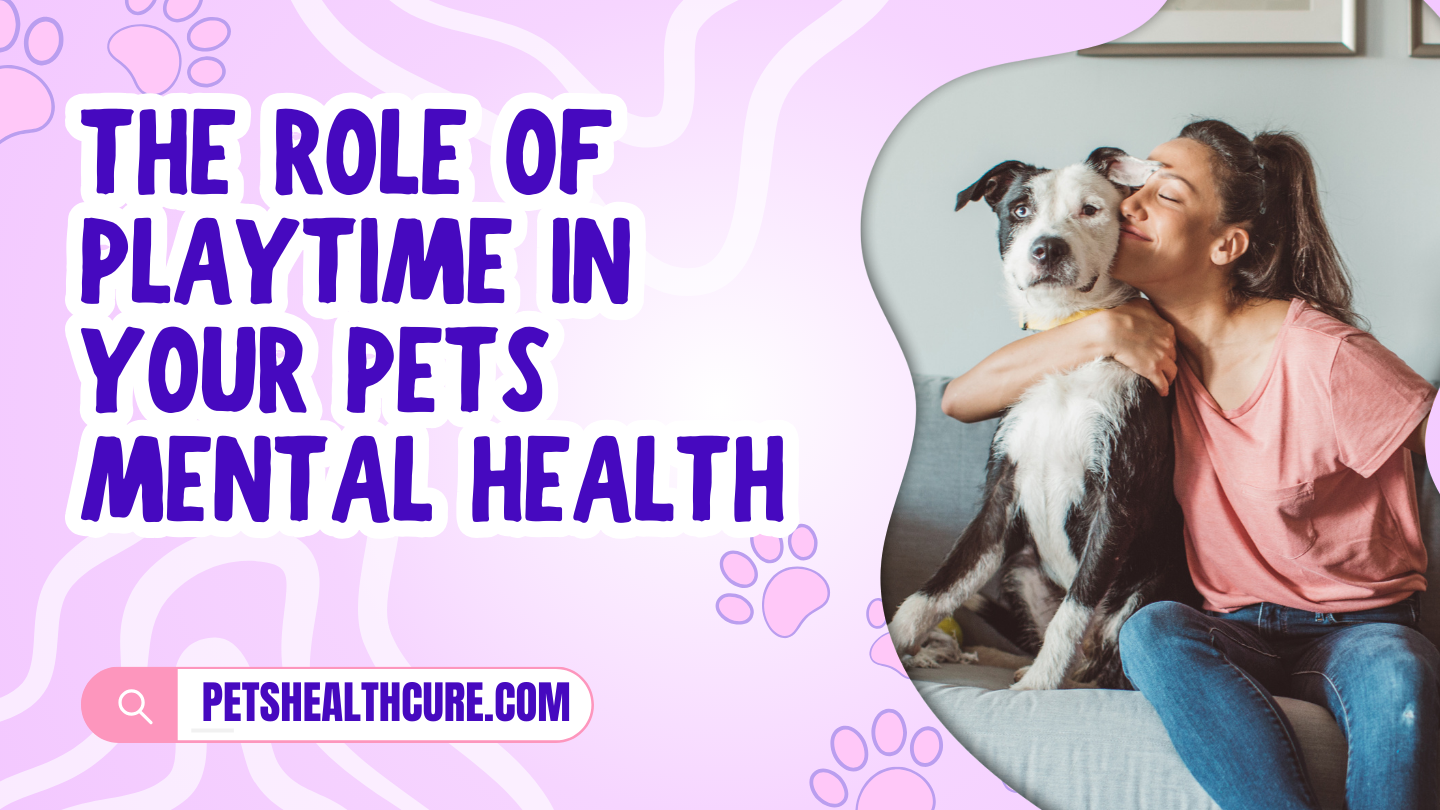Introduction to the Importance of Playtime
Playtime is not just a source of entertainment for pets; it serves as a vital pillar for their mental well-being. A well-stimulated pet is a happy pet, and consistent play can significantly enhance their emotional and cognitive health. In this article, we delve into how playtime positively impacts your pet’s mental health, ensuring a well-rounded and fulfilling life. So let’s start and learn The Role of Playtime in Your Pet’s Mental Health
Understanding Mental Stimulation Through Play
Pets, whether dogs, cats, or smaller companions, need mental stimulation to avoid feelings of boredom and frustration. Activities like interactive toys, puzzle feeders, and play sessions mimic natural behaviors, such as hunting or problem-solving. This helps keep their brains sharp and active.
- Improved Cognitive Function: Mental stimulation during play prevents cognitive decline and fosters learning abilities, particularly in young and aging pets.
- Stress Relief: Playtime reduces stress by releasing pent-up energy, leaving your pet calmer and more content.
- Behavioral Improvements: Engaged pets are less likely to exhibit destructive behaviors such as chewing, scratching, or barking excessively.
The Connection Between Physical Activity and Mental Health
Physical activity during play directly influences your pet’s mental state. Regular movement triggers the release of endorphins, the “feel-good” hormones, which elevate mood and reduce anxiety.
Key Benefits of Physical Play
- Reduced Anxiety: Structured play sessions can alleviate separation anxiety, especially in dogs.
- Enhanced Bonding: Activities like fetch, tug-of-war, or interactive laser pointers strengthen the bond between pets and owners.
- Better Sleep Patterns: Tired pets tend to sleep more soundly, improving their overall well-being.
Tailoring Playtime to Your Pet’s Personality
Every pet is unique, and understanding their preferences is key to a successful play session.
Playtime for Dogs
- Active Breeds: High-energy dogs thrive with fetch, frisbee, or agility exercises.
- Calmer Breeds: Snuffle mats and gentle tug toys work best for low-energy dogs.
Playtime for Cats
- Hunters at Heart: Cats enjoy toys that mimic prey, such as feather wands or battery-operated mice.
- Interactive Fun: Puzzle toys keep cats entertained and mentally stimulated.
Small Animals and Birds
Rabbits, hamsters, and parrots also benefit from tailored play. Toys that encourage chewing, climbing, or problem-solving can prevent boredom and foster natural behaviors.
How Play Prevents Mental Health Issues
Mental health issues in pets often arise from a lack of stimulation. Depression, anxiety, and aggression are common outcomes of prolonged neglect. Regular play counteracts these problems by offering a constructive outlet for energy and emotions.
Signs Your Pet Needs More Playtime
- Lethargy or Low Energy: A sign of boredom or depression.
- Aggressive or Destructive Behavior: Indicates frustration or excessive energy.
- Loss of Appetite or Withdrawal: Can signify emotional distress.
By recognizing these signs and increasing playtime, you can restore your pet’s mental equilibrium.
The Role of Interactive Toys in Mental Engagement
Interactive toys are game-changers for busy pet parents. These toys stimulate the mind, reduce loneliness, and provide hours of entertainment. Examples include:
- For Dogs: Kongs, treat-dispensing balls, and rope toys.
- For Cats: Laser pointers, scratching posts, and catnip-filled toys.
- For Small Animals: Tunnels, chew blocks, and climbing platforms.
Social Play and Its Impact
Social interaction is crucial for pets, particularly dogs, who are pack animals by nature. Playdates with other pets or group activities in controlled environments enhance their social skills and reduce isolation. Cats and other animals also benefit from human interaction or multi-pet households.
Incorporating Play Into Daily Routines
Consistency is the secret to reaping the benefits of playtime. Allocate specific times during the day for interactive activities to establish a routine.
Tips for Effective Playtime
- Morning Energy Burn: Start the day with a high-energy activity like fetch.
- Midday Breaks: Offer puzzle toys or solo activities during your work hours.
- Evening Bonding: Wind down with calm and interactive games before bedtime.
Conclusion: A Happier, Healthier Pet Through Play
Playtime is an indispensable component of your pet’s mental health. By investing time in structured, engaging, and enjoyable activities, you contribute to their emotional balance, cognitive growth, and overall happiness. Every minute spent playing strengthens the bond you share and ensures your pet leads a fulfilled life.
Faq’s (Frequently Asked Questions)
1. Why is playtime essential for my pet’s mental health?
Playtime provides mental stimulation, prevents boredom, and reduces stress. It mimics natural behaviors, helping pets feel engaged and fulfilled while improving cognitive function and emotional well-being.
2. How often should I engage my pet in play?
The frequency depends on your pet’s breed, age, and energy level. Generally, 30 minutes to 2 hours of daily playtime is recommended. Younger and more active pets may require more time, while senior pets might need gentler, shorter sessions.
3. What types of toys are best for my pet?
The best toys vary by species and preferences:
- Dogs: Chew toys, treat-dispensing balls, and fetch toys.
- Cats: Feather wands, laser pointers, and scratching posts.
- Small animals: Tunnels, chew blocks, and climbing structures.
4. Can playtime help with my pet’s behavioral issues?
Yes, regular play reduces destructive behaviors like chewing, scratching, or excessive barking. It channels energy into constructive activities, improving overall behavior and reducing anxiety.
5. How does playtime help with anxiety in pets?
Play releases endorphins, which are natural mood boosters. It also offers a constructive outlet for energy, helping to alleviate anxiety caused by boredom or separation.
6. What are the signs my pet needs more playtime?
Signs include lethargy, destructive behavior, aggression, loss of appetite, and withdrawal. These behaviors often indicate boredom or emotional distress, which can be alleviated through increased engagement.
7. Can older pets benefit from playtime?
Absolutely! Senior pets may not be as active, but gentle play and interactive toys keep their minds sharp and their spirits high. Activities like puzzle toys or slow walks are great for aging pets.
8. How can I incorporate playtime into my busy schedule?
Set aside small pockets of time during the day. Use interactive toys or puzzles that keep your pet entertained while you work. Short but consistent sessions are better than none.
9. What are the risks of neglecting playtime?
Lack of playtime can lead to mental health issues like depression, anxiety, and aggression. It may also result in physical health problems due to inactivity and weight gain.
10. How can I make playtime more engaging for my pet?
Rotate toys frequently to maintain interest, incorporate treats into activities, and choose games that mimic their natural instincts, like hunting or chasing.
11. Is social play important for pets?
Yes, social play is crucial for pets, especially dogs. Interaction with other pets or humans helps them develop social skills, reduces isolation, and enhances their emotional well-being.
12. Can small animals benefit from playtime?
Yes, rabbits, hamsters, and birds also need mental and physical stimulation. Providing tunnels, chew toys, or climbing platforms can keep them happy and healthy.
13. How does playtime strengthen the bond with my pet?
Engaging in play builds trust and affection between you and your pet. It fosters a positive association with you as their caregiver, strengthening your relationship.
14. Can indoor pets get enough exercise through playtime?
Yes, indoor pets can stay physically and mentally healthy with interactive toys, obstacle courses, and engaging activities tailored to their needs.


